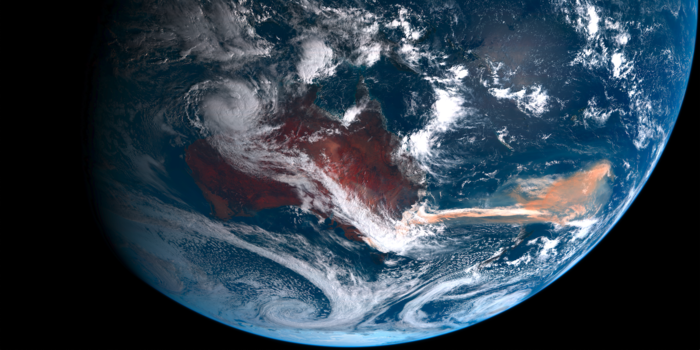DURHAM, N.C. – Clouds of smoke and ash from wildfires that ravaged Australia in 2019 and 2020 triggered widespread algal blooms in the Southern Ocean thousands of miles downwind to the east, a new Duke University-led study by an international team of scientists finds.

Credit: Japan’s National Institute of Information and Communication Technology
DURHAM, N.C. – Clouds of smoke and ash from wildfires that ravaged Australia in 2019 and 2020 triggered widespread algal blooms in the Southern Ocean thousands of miles downwind to the east, a new Duke University-led study by an international team of scientists finds.
The peer-reviewed study, published September 15 in Nature, is the first to conclusively link a large-scale response in marine life to fertilization by pyrogenic – or fire-made — iron aerosols from a wildfire.
It shows that tiny aerosol particles of iron in the windborne smoke and ash fertilized the water as they fell into it, providing nutrients to fuel blooms at a scale unprecedented in that region.
The discovery raises intriguing new questions about the role wildfires may play in spurring the growth of microscopic marine algae known as phytoplankton, which absorb large quantities of climate-warming carbon dioxide from Earth’s atmosphere through photosynthesis and are the foundation of the oceanic food web.
“Our results provide strong evidence that pyrogenic iron from wildfires can fertilize the oceans, potentially leading to a significant increase in carbon uptake by phytoplankton,” said Nicolas Cassar, professor of biogeochemistry at Duke’s Nicholas School of the Environment.
The algal blooms triggered by the Australian wildfires were so intense and extensive that the subsequent increase in photosynthesis may have temporarily offset a substantial fraction of the fires’ CO2 emissions, he said. But it’s still unclear how much of the carbon absorbed by that event, or by algal blooms triggered by other wildfires, remains safely stored away in the ocean and how much is released back into the atmosphere. Determining that is the next challenge, Cassar said.
Large wildfires, like the record-breaking blazes that devastated parts of Australia between 2019 and 2020 and the fires now raging in the western U.S., Siberia, the Amazon, the Mediterranean and elsewhere, are projected to occur more and more frequently with climate change, noted Weiyi Tang, a postdoctoral fellow in geosciences at Princeton University, who co-led the study as a doctoral candidate in Cassar’s lab at Duke.
“These fires represent an unexpected and previously under-documented impact of climate change on the marine environment, with potential feedbacks on our global climate,” Tang said.
Pyrogenic aerosols are produced when trees, brush and other forms of biomass are burned. Aerosol particles are light enough to be carried in a fire’s windborne smoke and ash for months, often over long distances.
While the new study focused on wildfires’ impacts in the Southern Ocean, other regions, including the North Pacific and areas near the equator where deeper, colder waters rise to the surface, “should also be responsive to iron additions from wildfire aerosols,” said Joan Llort, a postdoctoral fellow in marine biogeochemistry at the Barcelona Supercomputing Center, who co-led the study as a research fellow at the University of Tasmania’s Institute of Marine and Antarctic Studies.
Cassar and Richard Matear of Australia’s national science agency, CSIRO, were corresponding authors of the study, which was conducted by researchers from the University of Tasmania, Duke, the Barcelona Supercomputing Center, the CSIRO Oceans and Atmosphere program, and the Plymouth Marine Laboratory.
The scientists used satellite observations, robotic ocean floats, atmospheric transport modelling and measurements of atmospheric chemistry to track the spread of pyrogenic iron aerosols from the Australian wildfires and measure their impacts on marine productivity.
###
Funding came from France’s “Laboratoire d’Excellence” LabexMER and Investissements d’Avenir programs; a Harry H. Hess Postdoctoral Fellowship; the Australian Research Council; the CSIRO Decadal Climate Forecasting Project; the AXA Research Fund; and the European Union’s Horizon 2020 program.
In addition to his faculty post at Duke, Cassar holds a research appointment at the Laboratoire des Sciences de l’Environnement Marin of the Institut Universitaire Européen de la Mer in Brest, France
CITATION: “Widespread Phytoplankton Blooms Triggered by 2019-20 Australian Wildfires,” Weiyi Tang, Joan Llort, Jakob Weis, Morgane M. G. Perron, Sara Basart, Zuchuan Li, Shubha Sathyendranath, Thomas Jackson, Estrella Sanz Rodriguez, Bernadette C. Proemse, Andrew R. Bowie, Christina Schallenberg, Peter G. Strutton, Richard Matear and Nicolas Cassar. Nature, Sept. 15, 2021. DOI: 10.1038/s41586-021-03805-8
Journal
Nature
DOI
10.1038/s41586-021-03805-8
Method of Research
Observational study
Article Title
Widespread Phytoplankton Blooms Triggered by 2019-20 Australian Wildfires
Article Publication Date
15-Sep-2021




